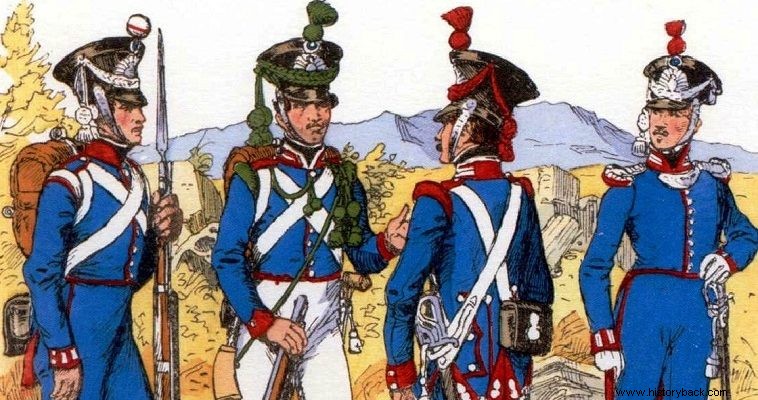
The arrival of Otto and the powerful Bavarian military force that accompanied him did much to curb the riots, at least initially. From the outset, the minor king entrusted the governance of the country to a committee of Bavarian technocrats. This commission of the regency, apart from the mistakes it committed on a political level, really worked with zeal for the revival of the Greek Army. He naturally had every reason to do so since a strong army would be the best support of the monarchy.
As a first step in this direction, it was decided to officially dissolve the theoretically existing units and establish a new army organization. Based on the new organization, the Greek Army, which included the Bavarian soldiers who accompanied Otto, would consist of eight battalions of the line, ten battalions of snipers, a cavalry regiment of six hils, the Artillery Command, the Engineers and the newly established Gendarmerie.
Organization, armament, tactics
The line battalions had six companies – four center, select and sniper. Their men were armed with the classic front-loading musket, bayonet and short sword. The non-commissioned officers and ten privates of each line skirmisher company were armed with front-facing rifled rifles. It was the first time that this weapon would be used, at least on such a scale, in the Greek Army. Rifled rifles had, of course, longer range than smoothbore muskets and much greater accuracy. The "shooters" of the battalions also carried a long bayonet - about 60 cm.
Each battalion was an autonomous unit capable of fighting in a company-front phalanx or platoon formation and in line formation, three fathoms deep. The skirmisher company was deployed 300 meters in front of the battalion bulk, either to support the battalion's energy with fire in the attack, or to provide depth in the defense.
Firing was carried out in pairs or groups by all the men of the battalion. The third pair of men did not place. His men were usually held in reserve. At other times they reinforced the skirmishers' company or were used to extend the battalion's front, which in this case was lined up two fathoms deep.
The line formation was mainly used when defending against infantry. For the attack, the formation of the dense (per company) or the simple (per division) phalanx was used. Infantry were capable of marching at a rate of 50 (in line) to 120 (in phalanx when charging) paces per minute. The grenadiers were arguably the strongest soldiers of the battalion.
They handled the difficult missions. Sometimes they reinforced the company of snipers. They usually formed the reserve of the battalion. In battle, the battalion's companies were traditionally lined up with the grenadiers on the right, the 1st, 2nd, 3rd and 4th central companies, in order, and the sniper company on the left.
The uniforms were light blue in color - the summer trousers were white in color. The hat was a black, Shako type with a brass radiant sun emblem and the letter O (Othon) with a crown representation. The snipers carried a small brass horn (bukino) on the cartridge case and the grenadiers an incendiary grenade (corresponding to those still worn today on the epaulettes of senior army officers).
The platoons were decorated with red plumes for the grenadiers, white for the central companies and green for the acrobolists. On the hat were worn, in official events, braided fabric cords analogous to the color of the plume. The equivalents of officers and non-commissioned officers were in the colors of gold and silver. The rank insignia were, according to German practice, worn on the collar.
The acrobolist battalions - light infantry - were much smaller than those of the line. Each had four companies of 50 men per company. The total strength of the light battalion did not exceed 220 men. Their armament did not differ from that of the battalions of the line, except that the hoplites did not carry swords. The light infantry uniform was a variation of the Greek traditional costume. A brass crown was worn on the fez.
The cavalry had a regiment of lancers of six hils. The horsemen were armed with lances, almost three meters long, curved long swords and front-mounted pistols. They were wearing a Polish-style uniform of green color. The Chapka-type platoon was red in color with a black visor and the same insignia as that of the line infantry. The cavalry fought either in a line two fathoms deep, or in an acrobolism formation, or in a phalanx. The Accountants Regiment had a total of 681 men.
The weapon of the Artillery was made up of the Artillery Command, an artillery battalion of six companies (two with guns) a company of pairs and the Directorate of Central Ordnance, to which the company of technicians also belonged. The gunners wore the same uniform as the purple line infantry. They were armed with short-barreled muskets, bayonets and double-edged swords. The couples carried cavalry swords.
The Engineer Command had two companies of pioneers and nine county "engineer" officers. Her strength in personnel was 207 men. Armament and uniform were the same as the artillery counterparts. Instead of a quotient, however, he wore a double-breasted hat.
The Gendarmerie, which was originally considered a military force, was organized into ten divisions with a total strength of 1,064 men.
In the organizational sector, the Military Secretariat, the General Staff Corps and the General Inspection of the Army were established by royal decrees. The Apomahon Company was also formed, to which the veterans of the Struggle who were unfit for service joined. Also, the ranks of first lieutenant and second lieutenant were abolished and the ranks of captain A and B class were established and the Order of Excellence of the Savior was established, in memory of the salvation of Greece from the Turkish yoke.
Thus at the end of 1833 the Greek Army had 5,824 infantry of the line, 2,040 light infantry, 681 cavalry, 990 gunners, journeymen and mates, 207 pioneers, three and later six staff officers, led by Scots Colonel Gordon and an Inspector General of the Army. Theoretically the strength of the army exceeded 10,000 men.
But in reality only 50% of the men served for reasons of economy. Most draftees, after basic training, were sent home on indefinite leave. The conduct of conscription was also problematic and the number of draftees called to serve annually did not exceed 1,500 men.
Reorganization
During Otto's reign the army organization of 1833 was modified several times.
In 1836 the eight line battalions were reduced to four. The light battalions were also reduced to four from ten. In place of the latter, eight militia battalions were formed, subordinate to three militia headquarters.
Each militia battalion fielded four companies with a total strength of 254 men. In 1843, another line battalion and the militia headquarters were abolished. Instead of the latter, four militia regiments, two battalions each, were formed. In the same year, the organization of the National Guard was established for the first time.
In 1854 and while the Crimean War was raging and the involvement of Greece was considered certain, the army was strengthened. Three battalions of the line were reconstituted and those of the snipers were combined into three, but strong, battalions. The Militia was also abolished.
During this period, many army officers resigned and went to the rebellious, still Ottoman, provinces of Epirus and Macedonia. Army officers, along with other volunteers, also enlisted in the Hellenic Legion . This battalion-sized body fought alongside the Russian Army at the siege of Sevastopol in 1855.
In 1856 the line battalions were joined by twos to regimental commands. In 1860 the regiments were abolished and the ten infantry battalions, which had been formed in the meantime, became autonomous again. Also in 1860, ten reserve battalions of the four companies were established. These battalions were enlisted units.
The cavalry also underwent a series of reorganizations during the same period. In 1836 the Accountants Regiment was disbanded and two independent cavalry squadrons were formed in its place. Each squadron originally had three and later two islands. Soon, however, the two squadrons merged into one of the three islands, which, from 1860, was called a hiparchy and acquired a fourth island.
Developments were also noted in the other weapons and bodies. In the Artillery the battalion was renamed a squadron. The squadron had two mountain and one plain artillery. In 1843, eight War Materiel Tax Offices were established, which came under Artillery. In 1863 the squadron was again renamed a battalion reinforced with a company of fortress artillery.
As regards the Engineer weapon, the Engineer Command was abolished and the Engineer Inspectorate established, until 1856, which was in turn abolished to establish Engineer Headquarters. In 1854, the Pioneer-Firemen regiment was formed.
Advances were also made in the organizational structure of the army. The Army Financial Inspection Service, a review military court, an additional permanent court-martial, four military bakeries and the Military Music of the Athens Guard were established. In 1861, the so-called disciplinary company was also formed, in which the hoplites who were consistently subject to serious disciplinary offenses were placed. The hoplites of the company worked on the public works.
In 1846, the Military Ministry was established instead of the Military Secretariat, while in 1861 the position of Inspector General was abolished and six Chambers of Finance and Material Management were established. In the field of personnel care, from 1835 already, the "Phalanx" was established, in which those fighters of '21 who did not wish to join the ranks of the regular army were assigned. In 1853 a care fund was established for the families of dead officers and in 1861 the demobilized fund was established.
In the field of education, the effort was focused on the training of executives, mainly. The Central Military School was renamed, in 1834, to the Evelpidon School. From time to time, various other schools (artillery officers, riflemen, battalion schools, etc.) also operated. Once a year large gymnasiums were held with the participation of units of all arms.
In the 1850s the army was also provided with new uniforms. The distinctive colors remained the same as before. Tight tunics were replaced by tights that reached up to the thighs.
New weapons, new tactics
There were significant changes in the armament of the army. From 1855 the Greek Army began to be equipped with the French front-loading rifled Mignet percussion rifle. The new weapon had nearly three times the effective range of the old muskets (about 300 meters) and was much easier to use. The Artillery was equipped with new howitzers and 6- and 12-pounder guns.
In terms of battle tactics, the French Campaign Regulations of 1845-46 were adopted . Based on the new regulation, the infantry fought in a two-way line formation, in a phalanx per division and in a cremation formation. The entire battalion was trained to operate in any type of terrain. In mountainous terrain, the battalion deployed all of its men in an acrobolism formation.
During the defense they deployed in a line formation. In this formation it was capable of firing all the men of the battalion at a rate of approximately four rounds per minute. A phalanx formation was used for the attack, even against a fortified position. Against cavalry, the infantry, theoretically at least, formed a square.
However, the greater range of the new rifles ensured the infantry relative survivability, even in line formation, as long as, of course, they kept their composure and had secured flanks.
Enlightened officers studied the lessons of the period's wars (Crimean, Italian Independence) and incorporated their findings into the new infantry campaign manual. The main characteristics of the Greek infantry were and are impetuousness during the attack and stubbornness during the defense.
The doctrine of the use of infantry was built on the special characteristics of the Greek infantry. As the natural outcome of an infantry conflict was considered to be a charge with the lance and the overthrow of the enemy by its use.
The artillery, due to the limited lifting capacity of the guns of the time, was necessarily placed in front of the front of the infantry, or in elevated places. His main mission was to inflict losses on the enemy's infantry and cavalry. The anti-aircraft missions were considered of secondary importance.
The role of the cavalry finally, due to the development in the armament of the infantry and due to the mountainous configuration of the Greek territory, was degraded. The main mission of the cavalry was to carry out reconnaissance to gather information and to pursue the defeated enemy army. Its usefulness, as an impact weapon, had also been limited due to its small force (only 400 men, in 1863).
The period of Otto's reign was extremely turbulent. However, it could also be characterized as a transitional period for the Greek Army. Despite the enormous difficulties during this period, the foundations were laid, mainly at the organizational level, for the formation of a strong army. The financial cachexia, the wrong mentality of the palaces, the political men, but also of many military men, did not contribute to the creation of a fighting army. Otho's reign was tested by 28 movements and rebellions.
During their duration, many times army units found themselves facing each other or facing armed civilians and bandits. In not a few cases brotherly blood was spilled while there were also laughable incidents, such as the stand of the 8th Militia Battalion in 1847, which, pursued by troops loyal to the throne, fled to Turkish-occupied territory! After that, the battalion was deleted from the force of the Greek Army.
Even events like this, however, should be charged as "children's diseases" in the Greek Army, which despite adversity continued to strengthen.
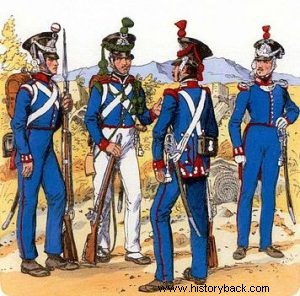
Infantry of the screen period. They can be seen from the right:a junior officer, a selectman, a grenadier, a skirmisher armed with a rifled rifle and a musketeer.
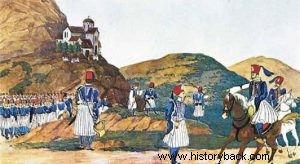
Light infantry of the period. The men wear traditional euzonian uniforms.
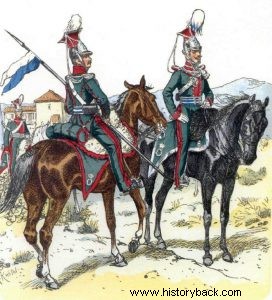
Greek horsemen with lances. They wear a Polish-style uniform with a Chapka-style quotient.
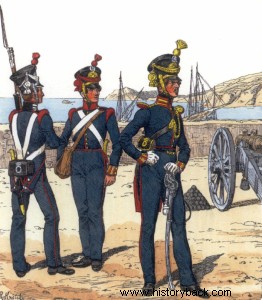
Officer, gunner and artillery mate.
